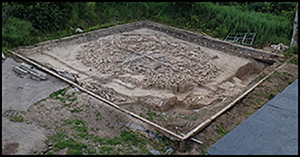Crossref Citations
This article has been cited by the following publications. This list is generated based on data provided by
Crossref.
Hussain, Shumon T.
2021.
The hooting past. Re-evaluating the role of owls in shaping human-place relations throughout the Pleistocene.
Anthropozoologica,
Vol. 56,
Issue. 3,
Dussex, Nicolas
Bergfeldt, Nora
de Anca Prado, Violeta
Dehasque, Marianne
Díez-del-Molino, David
Ersmark, Erik
Kanellidou, Foteini
Larsson, Petter
Lemež, Špela
Lord, Edana
Mármol-Sánchez, Emilio
Meleg, Ioana N.
Måsviken, Johannes
Naidoo, Thijessen
Studerus, Jovanka
Vicente, Mário
von Seth, Johanna
Götherström, Anders
Dalén, Love
and
Heintzman, Peter D.
2021.
Integrating multi-taxon palaeogenomes and sedimentary ancient DNA to study past ecosystem dynamics.
Proceedings of the Royal Society B: Biological Sciences,
Vol. 288,
Issue. 1957,
p.
20211252.
Reynolds, Natasha
Lisitsyn, Sergei N.
Eskova, Daria K.
Tsvetkova, Natalia A.
Buckley, Michael
and
Pustovalov, Aleksandr Yu
2021.
Kostënki 9: The chronology and lithic assemblage of a Gravettian site in Russia.
Quaternary International,
Vol. 587-588,
Issue. ,
p.
344.
Dinnis, Rob
Bessudnov, Alexander A
Reynolds, Natasha
Khlopachev, Gennady A
Sablin, Mikhail
Sinitsyn, Andrei
Higham, Thomas
and
Douka, Katerina
2021.
THE TEMPO OF CULTURAL CHANGE IN THE KOSTENKI UPPER PALEOLITHIC: FURTHER INSIGHTS.
Radiocarbon,
Vol. 63,
Issue. 3,
p.
785.
Thibodeau, Kenneth
2021.
Discerning Meaning and Producing Information: Semiosis in Knowing the Past.
Information,
Vol. 12,
Issue. 9,
p.
363.
Chu, Wei
and
Nett, Janina J.
2021.
The past in dust: current trends and future directions in Pleistocene geoarcheology of European loess.
Journal of Quaternary Science,
Vol. 36,
Issue. 8,
p.
1279.
Clark, Amy E.
Ranlett, Sarah
and
Stiner, Mary C.
2022.
Domestic spaces as crucibles of Paleolithic culture: An archaeological perspective.
Journal of Human Evolution,
Vol. 172,
Issue. ,
p.
103266.
French, Jennifer C.
and
Nowell, April
2022.
Growing up Gravettian: Bioarchaeological perspectives on adolescence in the European Mid-Upper Paleolithic.
Journal of Anthropological Archaeology,
Vol. 67,
Issue. ,
p.
101430.
Murphree, William Chase
and
Aldeias, Vera
2022.
The evolution of pyrotechnology in the Upper Palaeolithic of Europe.
Archaeological and Anthropological Sciences,
Vol. 14,
Issue. 10,
Koç, Varol
2022.
Living inside a mammoth.
Time and Mind,
Vol. 15,
Issue. 3-4,
p.
343.
Fontana, Laure
2022.
Reindeer Hunters of the Ice Age in Europe.
p.
203.
Katz, Ofir
2022.
The ecosystem services framework in archaeology (and vice versa).
People and Nature,
Vol. 4,
Issue. 6,
p.
1450.
Townsend, Cathryn
Ferraro, Joseph V.
Habecker, Heather
and
Flinn, Mark V.
2023.
Human cooperation and evolutionary transitions in individuality.
Philosophical Transactions of the Royal Society B: Biological Sciences,
Vol. 378,
Issue. 1872,
Djindjian, François
and
Iakovleva, Lioudmila
2023.
LA QUESTION DE L’EPIGRAVETTIEN ORIENTAL.
Światowit,
p.
146.
Petrova, Ekaterina A.
Voyta, Leonid L.
Bessudnov, Alexander A.
and
Sinitsyn, Andrey A.
2023.
An integrative paleobiological study of woolly mammoths from the Upper Paleolithic site Kostenki 14 (European Russia).
Quaternary Science Reviews,
Vol. 302,
Issue. ,
p.
107948.
Holliday, Vance T.
and
Hoffecker, John F.
2023.
Encyclopedia of Geoarchaeology.
p.
1.
Hoffecker, John F.
Elias, Scott A.
Scott, G. Richard
O'Rourke, Dennis H.
Hlusko, Leslea J.
Potapova, Olga
Pitulko, Vladimir
Pavlova, Elena
Bourgeon, Lauriane
and
Vachula, Richard S.
2023.
Beringia and the peopling of the Western Hemisphere.
Proceedings of the Royal Society B: Biological Sciences,
Vol. 290,
Issue. 1990,
Gamble, Clive
2023.
The house as a mind.
F1000Research,
Vol. 12,
Issue. ,
p.
301.
Thiry, Médard
and
Milnes, Anthony
2024.
Engineered ‘landmarks’ associated with Late Paleolithic engraved shelters.
Journal of Archaeological Science: Reports,
Vol. 55,
Issue. ,
p.
104490.
Olsson, Ola
2024.
Paleoeconomics.
p.
119.



